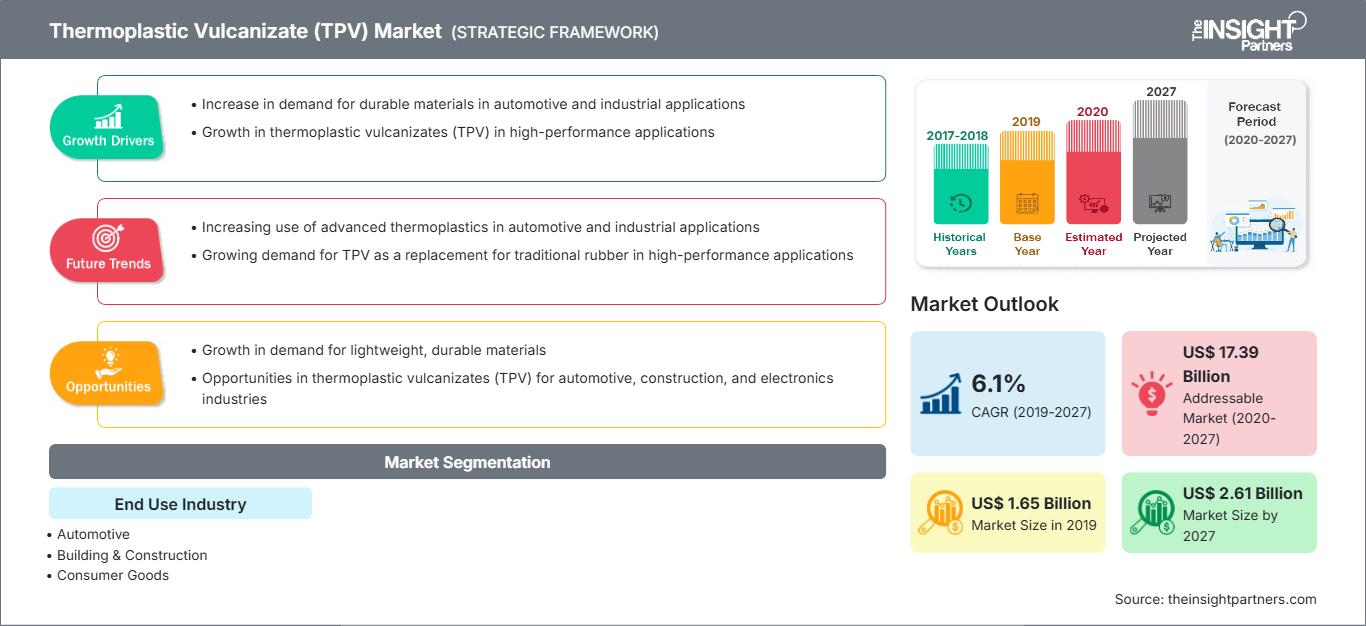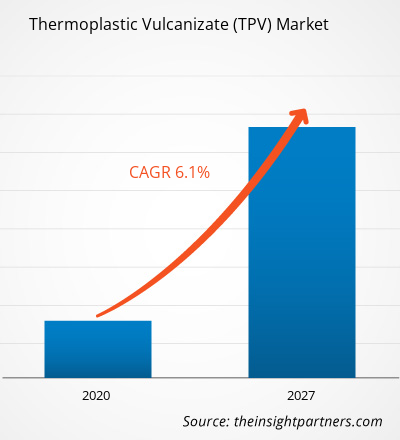Der Markt für thermoplastische Vulkanisate (TPV) wurde 2019 auf 1.646,78 Millionen US-Dollar geschätzt und soll bis 2027 2.612,50 Millionen US-Dollar erreichen; im Prognosezeitraum wird ein CAGR-Wachstum von 6,1 % erwartet.
Thermoplastische Vulkanisate werden in einer Vielzahl von Produkten verwendet, beispielsweise in Waschmaschinen und Trocknern, Geschirrspülern, Kleingeräten, Griffen und Dichtungen sowie Kühlschränken, für starre Teile und Dichtungen. Die Nachfrage nach thermoplastischen Vulkanisaten im Konsumgütersektor wird voraussichtlich steigen, da sie als leichtes, vielseitiges und weiches Material in verschiedenen Anwendungsbereichen wie Kleidung, Haushaltsgeräten, Körperpflegeprodukten, Küchengeschirr und Elektrowerkzeugen zum Einsatz kommen. Darüber hinaus wird erwartet, dass sich das Wachstum der Konsumgüterindustrie in den BRIC-Staaten ebenfalls positiv auf den Markt für thermoplastische Vulkanisate auswirken wird. Thermoplastische Vulkanisate (TPV) bieten hervorragende Effizienz, reduzierte Systemkosten und potenzielle Nachhaltigkeit. Aufgrund dieser Vorteile werden TPVs in der Konsumgüterindustrie eingesetzt. ExxonMobil Chemical produziert beispielsweise thermoplastische Vulkanisate (TPVs) mit Hochleistungselastomeren, die vielseitig in der Produktion, einfach zu verarbeiten und langlebig sind. Durch die überlegene und gleichbleibende Leistung in industriellen und anspruchsvollen Verbraucheranwendungen bietet TPV das Potenzial für niedrigere Gerätekosten, geringeres Gewicht und Recyclingfähigkeit im Vergleich zu Materialien wie EPDM (Ethylen-Propylen-Dien-Polymethylen-Rückgrat) oder anderen duroplastischen Kautschuken.
Nordamerika wird im Prognosezeitraum voraussichtlich den größten Anteil am globalen Markt für thermoplastische Vulkanisate (TPV) halten. Mehrere nationale und internationale Unternehmen haben in der nordamerikanischen Region eine starke Position. Das Wachstum des Marktes für thermoplastische Vulkanisate (TPV) in dieser Region ist hauptsächlich auf die steigende Nachfrage nach Leichtbaumaterialien für die Produktion verschiedener Autokomponenten zurückzuführen. Darüber hinaus dürften günstige staatliche Bestimmungen zum TPV-Verbrauch in Automobilanwendungen als Alternative zu Legierungen und Metallen sowie die steigende Pkw-Produktion in den USA und Mexiko das regionale Marktwachstum im Prognosezeitraum weiter ankurbeln. Technische Entwicklungen und die wachsende Nachfrage nach Elektrofahrzeugen haben zudem den Bedarf an leichten, robusten und recycelbaren Gütern erhöht, was wiederum das Marktwachstum vorangetrieben hat.
Die USA, Indien, Brasilien, Russland, Frankreich, das Vereinigte Königreich, die Türkei, Italien und Spanien gehören im Hinblick auf die bestätigten Fälle und gemeldeten Todesfälle aufgrund von COVID-19 im Dezember 2020 zu den am stärksten betroffenen Ländern. Laut WHO-Daten wurden im Dezember 2020 weltweit ca. 80.453.105 bestätigte Fälle und 1.775.776 Todesfälle gemeldet. Die COVID-19-Pandemie hat die Volkswirtschaften durch Lockdowns, Reiseverbote und Geschäftsschließungen beeinträchtigt. Die globale Chemie- und Werkstoffindustrie ist einer der größten Wirtschaftszweige, die aufgrund dieser Beschränkungen Lieferkettenunterbrechungen und Produktionsstörungen hinnehmen muss. China ist das globale Zentrum der Produktion und der größte Rohstofflieferant für verschiedene Branchen. Die Schließung verschiedener Werke und Fabriken in führenden Regionen wie dem Asien-Pazifik-Raum und Europa beeinträchtigt die globalen Lieferketten und wirkt sich negativ auf Produktion, Lieferpläne und Produktverkäufe aus. Diese Faktoren wirken sich negativ auf das Wachstum des globalen Marktes für thermoplastische Vulkanisate (TPV) aus.
Passen Sie diesen Bericht Ihren Anforderungen an
Sie erhalten kostenlos Anpassungen an jedem Bericht, einschließlich Teilen dieses Berichts oder einer Analyse auf Länderebene, eines Excel-Datenpakets sowie tolle Angebote und Rabatte für Start-ups und Universitäten.
Markt für thermoplastische Vulkanisate (TPV): Strategische Einblicke

-
Holen Sie sich die wichtigsten Markttrends aus diesem Bericht.Dieses KOSTENLOSE Beispiel umfasst Datenanalysen, die von Markttrends bis hin zu Schätzungen und Prognosen reichen.
Um die Abhängigkeit von nicht erneuerbaren Ressourcen wie Erdöl zu minimieren und eine nachhaltige Entwicklung der Polymerwerkstoffindustrie zu erreichen, bevorzugen viele Menschen biobasierte Polymerwerkstoffe. Biobasierte thermoplastische Vulkanisate (TPV) bestehen aus Poly(lactid) (PLA) und Ethylen-co-Vinylacetat-Kautschuk (EVA), die unter Verwendung von Dicumylperoxid (DCP) als Härtungsmittel hergestellt wurden; die Anwendung von PLA in elastischen Materialien wurde erstmals nachgewiesen. Da biobasierte TPVs geringe Kohlenstoffemissionen aufweisen und biologisch abbaubar sind, wird ihre Synthese in den meisten Ländern gefördert. Sie gelten derzeit als nachhaltige Alternativen zu herkömmlichen erdölbasierten Polymeren, da sie aus erneuerbaren Ressourcen wie stärkebasierten Polymeren, Polylactiden (PLAs), Polyhydroxyalkanoaten (PHAs), cellulosebasierten Polymeren und sojabasierten Polymeren gewonnen werden. Da biobasierte TPEs nicht nur eine saubere Lösung darstellen, sondern den Herstellern biobasierter TPEs auch Kostenwettbewerbsfähigkeit gegenüber ihren synthetischen Pendants ermöglichen, dürften sie erhebliche Marktwachstumschancen schaffen.
Einblicke in die Endverbraucherbranche
Basierend auf der Endverbraucherbranche ist der Markt für thermoplastische Vulkanisate (TPV) in die Branchen Automobil, Bauwesen, Konsumgüter, Gesundheitswesen und Sonstige unterteilt. Im Jahr 2019 dominierte das Automobilsegment den Markt. Leichtbaumaterialien für die Automobilindustrie haben in den letzten Jahren aufgrund der steigenden Nachfrage nach luxuriösen, emissionsarmen, sicheren und leistungsstarken Fahrzeugen ein starkes Wachstum erlebt. Infolgedessen haben Zulieferer und Hersteller eine Reihe von Lösungen auf den Markt gebracht, die OEMs nicht nur dabei helfen, strenge Vorschriften einzuhalten, sondern auch die wachsende Bandbreite persönlicher Kundenanforderungen zu erfüllen. TPVs sind zudem eine sinnvolle Alternative zu teuren Elastomeren. Sie bieten eine ausgezeichnete elastomere Haltbarkeit, einschließlich relativ hoher Zugfestigkeit und Bruchdehnung, hoher elastischer Rückstellkraft sowie guter Dimensionsstabilität in Heißluft und ausgezeichneter Beständigkeit gegen UV-Alterung, Ozon und Witterungseinflüsse. Zu den wichtigsten Anwendungen von TVP in der Automobilindustrie gehören Schlauchabdeckungen, Lufteinlasskanalabdeckungen, Dichtungen, Faltenbälge, Schwingungsdämpfer, Federbein-Abdeckungen, Zündungsteile, Buchsen und Fensterdichtungen. Zu den flexiblen TPV-Motorraumkomponenten im Automobilbereich gehören Luftansaugrohre und -bälge, Radkastenverbreiterungen, Bälge des Lenksystems und Schallschutzteile. Darüber hinaus sind TPVs 10–30 % günstiger als EPDM, bei gleichzeitig geringerem Gewicht, größerer Designflexibilität und Recyclingfähigkeit.
Mitsui Chemicals Inc., Celanese Corporation, Mitsubishi Chemical Corporation, Kumho Polychem, Trinseo, Teknor Apex, ExxonMobil, Zeon Chemicals LP, Alphagary und Ravago gehören zu den wichtigsten Akteuren auf dem globalen Markt für thermoplastische Vulkanisate (TPV). Diese Unternehmen entwickeln neue Produkte und setzen Fusions- und Übernahmestrategien um, um ihren jeweiligen Kundenstamm zu erweitern und signifikante Marktanteile auf dem Weltmarkt zu gewinnen, was ihnen wiederum ermöglicht, ihren Markennamen zu behaupten.
Berichts-Spotlights
- Fortschreitende Branchentrends auf dem globalen Markt für thermoplastische Vulkanisate (TPV), die den Akteuren bei der Entwicklung effektiver langfristiger Strategien helfen
- Geschäftswachstumsstrategien in entwickelten und sich entwickelnden Märkten
- Quantitative Analyse des globalen Marktes für thermoplastische Vulkanisate (TPV) von 2017 bis 2027
- Schätzung der globalen Nachfrage nach thermoplastischen Vulkanisaten (TPV) in verschiedenen Branchen
- PEST-Analyse zur Veranschaulichung der Effektivität von Käufern und Lieferanten in der Branche
- Jüngste Entwicklungen zum Verständnis des Wettbewerbsmarktszenarios und der globalen Nachfrage nach thermoplastischen Vulkanisaten (TPV)
- Markttrends und -aussichten sowie Faktoren, die das Wachstum des globalen Marktes für thermoplastische Vulkanisate (TPV) fördern und hemmen Markt
- Verständnis der Strategien, die das kommerzielle Interesse im Hinblick auf das Marktwachstum untermauern
- Globale Marktgröße für thermoplastische Vulkanisate (TPV) an verschiedenen Marktknotenpunkten
- Detaillierte Übersicht und Segmentierung des Marktes sowie seiner Branchendynamik
- Globale Marktgröße für thermoplastische Vulkanisate (TPV) in verschiedenen Regionen mit vielversprechenden Wachstumschancen in den jeweiligen Regionen
Thermoplastisches Vulkanisat (TPV)
Regionale Einblicke in den Markt für thermoplastische Vulkanisate (TPV)Die Analysten von The Insight Partners haben die regionalen Trends und Faktoren, die den Markt für thermoplastische Vulkanisate (TPV) im Prognosezeitraum beeinflussen, ausführlich erläutert. In diesem Abschnitt werden auch die Marktsegmente und die geografische Lage für thermoplastische Vulkanisate (TPV) in Nordamerika, Europa, im asiatisch-pazifischen Raum, im Nahen Osten und Afrika sowie in Süd- und Mittelamerika erörtert.
Umfang des Marktberichts über thermoplastische Vulkanisate (TPV)
| Berichtsattribut | Einzelheiten |
|---|---|
| Marktgröße in 2019 | US$ 1.65 Billion |
| Marktgröße nach 2027 | US$ 2.61 Billion |
| Globale CAGR (2019 - 2027) | 6.1% |
| Historische Daten | 2017-2018 |
| Prognosezeitraum | 2020-2027 |
| Abgedeckte Segmente |
By Endverbrauchsindustrie
|
| Abgedeckte Regionen und Länder |
Nordamerika
|
| Marktführer und wichtige Unternehmensprofile |
|
Marktdichte der Akteure im Bereich thermoplastisches Vulkanisat (TPV): Verständnis ihrer Auswirkungen auf die Geschäftsdynamik
Der Markt für thermoplastische Vulkanisate (TPV) wächst rasant. Dies ist auf die steigende Endverbrauchernachfrage zurückzuführen, die auf Faktoren wie veränderte Verbraucherpräferenzen, technologische Fortschritte und ein stärkeres Bewusstsein für die Produktvorteile zurückzuführen ist. Mit der steigenden Nachfrage erweitern Unternehmen ihr Angebot, entwickeln Innovationen, um den Bedürfnissen der Verbraucher gerecht zu werden, und nutzen neue Trends, was das Marktwachstum weiter ankurbelt.

- Holen Sie sich die Markt für thermoplastische Vulkanisate (TPV) Übersicht der wichtigsten Akteure
- Automobilindustrie
- Bauwesen
- Konsumgüter
- Gesundheitswesen
- Sonstige
Unternehmensprofile
- Mitsui Chemicals Inc.
- Celanese Corporation
- Mitsubishi Chemical Corporation
- Kumho Polychem
- Trinseo
- Teknor Apex
- ExxonMobil
- Zeon Chemicals LP
- Alphagary
- Ravago
- Historische Analyse (2 Jahre), Basisjahr, Prognose (7 Jahre) mit CAGR
- PEST- und SWOT-Analyse
- Marktgröße Wert/Volumen – Global, Regional, Land
- Branchen- und Wettbewerbslandschaft
- Excel-Datensatz
Aktuelle Berichte
Erfahrungsberichte
Grund zum Kauf
- Fundierte Entscheidungsfindung
- Marktdynamik verstehen
- Wettbewerbsanalyse
- Kundeneinblicke
- Marktprognosen
- Risikominimierung
- Strategische Planung
- Investitionsbegründung
- Identifizierung neuer Märkte
- Verbesserung von Marketingstrategien
- Steigerung der Betriebseffizienz
- Anpassung an regulatorische Trends






















 Kostenlose Probe anfordern für - Markt für thermoplastische Vulkanisate (TPV)
Kostenlose Probe anfordern für - Markt für thermoplastische Vulkanisate (TPV)